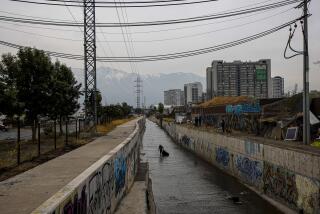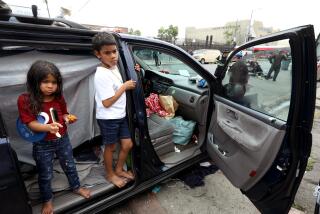Project Provides Hope to Street Kids of Honduras
- Share via
TEGUCIGALPA, Honduras — Three dirty, barefoot children dressed in rags approach a passer-by with outstretched hands.
“Give me 10 cents,” one of them pleads in a dull, practiced voice, his dark eyes registering only a flicker of surprise when the man gives him a coin.
It is a common sight in almost every Latin American city. But this time, it is the Honduran capital of Tegucigalpa, a city of 580,000 where hundreds of homeless children struggle daily to survive on the streets.
Most of the children live by begging, carrying bags for customers at the city’s open-air market and committing petty thefts.
“I have to get by on what I get on the street,” said one of the youths, who said his name was Oscar. “There is an old lady at the market who sometimes gives me something to eat or lets me sleep in her house.
“It’s better than living at home. There wasn’t any food there, either, and my mother always hit me.”
Asked if life on the streets is
hard, Oscar’s cautious smile disappeared, and he looked around at his companions.
“I don’t know,” he said blankly, then limped off toward another pedestrian.
Homeless street children are not a new phenomenon in Honduras, the third-poorest country in the Western Hemisphere, after Haiti and Bolivia. But their numbers have increased sharply in recent years, a result of rising poverty and rapid population growth.
Tegucigalpa is one of the fastest-growing cities in Latin America, with rural Hondurans fleeing the grinding poverty of the countryside for slums in the city that crop up quickly on the hills surrounding the capital.
A continuing economic slump, with 25% unemployment, has meant that more parents are either unable or unwilling to provide for their children, forcing the youths to fend for themselves on the street.
But Honduras today is also host to the hemisphere’s most ambitious project aimed at helping street children.
Diamond Project
A network of dozens of halfway houses for the children is being created in urban areas, funded by government, private and international aid. The centerpiece of the network is Proyecto Diamante, or Diamond Project, a sprawling complex in the countryside 25 miles northwest of Tegucigalpa that until 1985 was a hospital for Nicaraguan rebels based in Honduras.
“We take the most incorrigible boys, the ones that the halfway houses in urban areas cannot handle,” Juan Carrasco, the project’s director, said. “Most of them were either resistoleros or were serious disciplinary problems.”
“Resistoleros” is the nickname for street children who sniff Resistol, the major brand of glue in Honduras. Resistol’s fumes cause euphoria and wild mood swings. They also have been linked to much local street crime.
The Diamond Project, which houses about 60 boys, is a pilot program of UNICEF. Construction of new dormitories is expected to raise the total number of beds to 200 by the end of 1988 and to 500 by the early 1990s.
Self-Help Emphasized
What makes the project unique is its emphasis on self-help. The children clean their own living quarters, grow much of their own food and earn in-house currency by working in various center businesses, such as a T-shirt printing shop. The boys can use the money to buy snacks, open an account at the savings bank or buy their own clothes.
“At first, two years ago, we gave the kids their clothes,” Carrasco said. “But they wouldn’t take care of them, and they would throw them away. If you look at the bottom of that pond over there, you will find the bottom is covered with shoes.
“So now we make the kids buy everything, from clothes to soap.”
At the project’s store, soap costs 20 cents, and shoes, shirts and pants are 50 cents each.
‘Nobody Bothers Me’
“If you ask them now, they will say they wouldn’t go back to the old way,” Carrasco said.
“Here I’m making something of my life,” Beta, an 18-year-old with a severely curved spine, said as he tended a patch of vegetables. “Here I’ve got this patch for myself, and nobody bothers me.”
Grinning shyly, he said he wants to be a farmer.
“On the streets, I was just running around, always hungry, and my aunt would hit me whenever she found me,” he said. “It was hell.”
Some Less Optimistic
Organizers of the center expect it to become a model for much of Latin America and the focal point of a network that will solve Honduras’ mounting problem with homeless children.
Other experts, however, are less optimistic.
“The Diamond Center, and the rest of the private and public efforts to help street children, are doing a lot of necessary, important work,” Dr. Antonio Casas, UNICEF director for Honduras, said. “There has been a big effort now for several years now to make Honduras an international example.
“But I don’t see things getting better for Honduran children in general, unless underlying changes are made in the country’s production and land-tenure system. No matter how much is done for some street children, the basic demographic and economic outlook is not good.”
But such debates are of little interest at the Diamond Project.
Hector, a diminutive 13-year-old making a wastebasket in the carpentry shop, was asked if he preferred the center to the streets.
He smiled slowly, pointed with his hammer at the busy children and flying sawdust around him, and said firmly, “Yes.”
More to Read
Sign up for Essential California
The most important California stories and recommendations in your inbox every morning.
You may occasionally receive promotional content from the Los Angeles Times.













